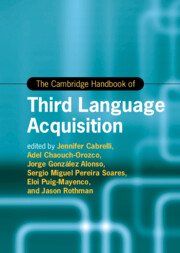Book contents
- The Cambridge Handbook of Third Language Acquisition
- Cambridge Handbooks in Language and Linguistics
- The Cambridge Handbook of Third Language Acquisition
- Copyright page
- Contents
- Figures
- Tables
- Contributors
- Introduction Multilingualism
- Part I Theoretical Approaches to L3/Ln
- Part II L3/Ln across Linguistic Domains
- Part III Becoming and Staying Multilingual at Different Ages
- Part IV L3/Ln in Action
- Part V L3/Ln and Cognition
- Part VI Research Methods in L3/Ln
- 25 Innovations and Challenges in Acquisition and Processing Methodologies for L3/Ln
- 26 Corpus Research
- 27 Case Study Research in Multilingual Contexts
- 28 Using Artificial Languages to Study Third Language Learning and Processing
- 29 Statistical Modeling in L3/Ln Acquisition
- Index
- References
26 - Corpus Research
from Part VI - Research Methods in L3/Ln
Published online by Cambridge University Press: 13 July 2023
- The Cambridge Handbook of Third Language Acquisition
- Cambridge Handbooks in Language and Linguistics
- The Cambridge Handbook of Third Language Acquisition
- Copyright page
- Contents
- Figures
- Tables
- Contributors
- Introduction Multilingualism
- Part I Theoretical Approaches to L3/Ln
- Part II L3/Ln across Linguistic Domains
- Part III Becoming and Staying Multilingual at Different Ages
- Part IV L3/Ln in Action
- Part V L3/Ln and Cognition
- Part VI Research Methods in L3/Ln
- 25 Innovations and Challenges in Acquisition and Processing Methodologies for L3/Ln
- 26 Corpus Research
- 27 Case Study Research in Multilingual Contexts
- 28 Using Artificial Languages to Study Third Language Learning and Processing
- 29 Statistical Modeling in L3/Ln Acquisition
- Index
- References
Summary
This chapter provides an overview of research into L3/Ln that is based on corpus data, and provide the reader with information on publicly available L3/Ln corpora. As both L3/Ln corpus-based research and corpora are quite scarce to date, I devote the better part of this chapter to describing the outcome of a survey I conducted to gather colleagues’ needs and preferences regarding future L3/Ln corpus compilations.
- Type
- Chapter
- Information
- The Cambridge Handbook of Third Language Acquisition , pp. 683 - 695Publisher: Cambridge University PressPrint publication year: 2023
References
- 1
- Cited by

